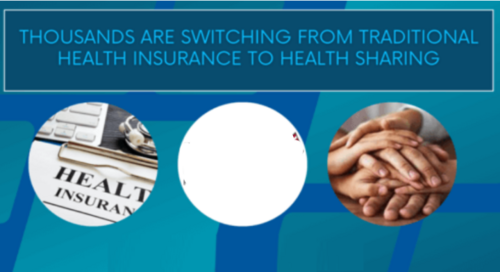

The American healthcare landscape has been undergoing significant shifts. Between health insurance and health sharing, many more options are now available.
The promises of the Affordable Care Act have long since fizzled. Instead, Americans are faced with soaring health insurance premiums, sky-high deductibles, and complex insurance policies.
As a result, increasing numbers of Americans have turned to a more efficient, lower-cost alternative to traditional health insurance approaches: health sharing.
According to the Alliance of Health Care Sharing Ministries, at least 1.7 million people nationwide are already members of health sharing ministry organizations as of mid-2023.
And since the Alliance represents just a few of the dozens of active health sharing ministry organizations, that figure is almost certainly underreported.
So, what’s driving this mass transition away from traditional health insurance to health sharing?
A number of factors, including:
This blog post will explore each of these factors in turn. We’ll conclude with links to several resources where you can learn more about health sharing, and even sign up for a plan yourself in just minutes.
Lastly, there’s a list of Frequently Asked Questions about health sharing at the end of this page.
Generally, traditional health insurance companies are for-profit companies.
That means they’re run for the benefit of stockholders. Not members.
Health sharing organizations, on the other hand, are 501(c)3 non-profit entities. They’re run for the benefit of members, not Wall Street.
Members contribute a predefined amount, each month, called a “share,” which is pooled and used to cover medical expenses for members who need it.
Traditional health insurance plans have become prohibitively expensive – especially for people who don’t get an Obamacare premium subsidy.
According to the Kaiser Family Foundation, the average unsubsidized cost of an Affordable Care Act-qualified “silver” tier marketplace plan available over the exchanges now tops $1200 per month, or $24,000 per year.
And you still have to pay up to 30% of your medical bills out of pocket (up to your out-of-pocket maximum) of $9,800, as of 2023.
Health sharing plans, in contrast, cost roughly 40 to 50% less on a monthly basis compared to unsubsidized Obamacare insurance costs.
And in most cases, health share plans don’t require you to pay that extra 30% in coinsurance costs.
Normally, with health sharing plans, you just have to cover your initial unshareable amount (sometimes called a member responsibility amount), which functions similarly to a health insurance deductible.
You cover your initial unshareable amount, and then your plan’s cost sharing features kick in.
After that, most healthsharing plans will pick up 100% of eligible costs for most medical events. However, a few health sharing plans have annual or lifetime caps on sharing, which help keep monthly costs low, but increase members’ risk.
How Much Money Can Healthsharing Save?
Traditional insurance plans often come with “narrow networks,” limiting your access to a specific group of providers and hospitals.
This can be particularly problematic if you require specialized care that is not available within the network. Healthsharing liberates you from these confines, offering you a broader range of options.
One of the hallmarks of health sharing is its commitment to healthcare freedom.
Unlike restrictive HMO and PPO networks that limit your choices, most healthsharing plans allow you to choose any doctor or specialist you prefer.
This autonomy means you’re not confined to the lowest bidders in a network, enabling you to seek the highest quality of care.
Price transparency is a significant benefit in health sharing models.
Because healthshare plan members are technically “cash payers,” they routinely get discounted pricing from healthcare providers.
Under recent medical price transparency laws, hospitals and other providers must clearly disclose their pricing for all medical procedures they offer – including discounted pricing for cash payers.
Additionally, most health share plans have a full-time department of expert health care concierge staffers. Their job is to help you research providers to help you identify the ones that offer the best possible value.
They also help you negotiate the best possible pricing for scheduled/elective medical services – provided you use them.
Many health sharing organizations also negotiate directly with providers to secure lower prices for services, thereby reducing out-of-pocket expenses for their members.
This service is especially valuable if you are in generally good health, and typically don’t expect to reach your initial unshareable amount: Any discounts you can secure by being a member of a healthshare plan benefit you directly, by lowering your out-of-pocket costs.
Many people are attracted to health sharing because it aligns with their ethical or religious beliefs.
While many health sharing ministries are non-denominational, or even secular, many others operate on faith-based principles.
As such, many plans do not share costs related to services and procedures members may find objectionable or abhorrent – something traditional health insurance rarely accommodates.
For example, many health sharing plans don’t share costs related to abortion, in vitro fertilization.
Some plans require members to be married to be eligible for maternity or childbirth cost sharing.
Healthshare plans also typically require members to live health conscious and drug-free lifestyles. They therefore often limit or exclude sharing of costs related to drunk driving accidents and drug and alcohol addictions treatment.
For those who don’t abuse drugs or drink to excess, this is a feature, not a bug, because it helps keep costs down for all members.
Though they serve similar functions, health sharing is not the same as health insurance.
In a health insurance model, a contract obliges the insurer to pay for certain costs associated with your healthcare.
Health sharing, however, is more of a community-based approach where members voluntarily share each other’s medical expenses. There’s no guarantee of payment. But healthshare plans have a long history of shared responsibility and community support.
According to the Alliance of Health Care Sharing Ministries, 108 healthsharing ministries successfully share more than $1.3 billion in medical costs for members each year.
Whether it’s the significant cost-saving potential, the freedom to choose your healthcare providers, or ethical alignment, health sharing is making its mark as a legitimate alternative to conventional health insurance.
If you’re tired of high premiums, limited choices, and opaque billing, consider making the switch.
To learn more about healthshare plans, to get a quote from some of America’s top-selling health share or health insurance plans, and to enroll in just minutes, year round
